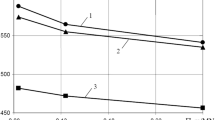Abstract
Although there is now a considerable volume of high-strain (<105 cycles) fatigue data for uniaxial tension-compression and simple-bending conditions, relatively little information is available regarding the effects of stress and strain biaxiality. A method which has been used to study the effects of biaxiality on longlife fatigue strength is to subject thin-walled tubes to repeated internal pressure and an end load which is in phase with, and a linear function of, the pressure. The object of the present research was to use this method to study the influence of stress biaxiality on the high-strain fatigue behavior of a high strength, aluminum-4% copper alloy at room temperature. From a continuum-mechanics point of view, this material is completely elastic after the first few load cycles. Cylinder results for hoop to axial stress ratios of 2:1, 1:1, 1:2 and 2: −1 suggest that fatigue failure of this material in the life range 103 to 105 cycles is primarily dependent on the maximum range of tensile stress. This conclusion and a study of fracture surfaces led to the use of linear-elastic fracture mechanics to interpret the fatigue and brittle fracture behavior of these cylinders.
Similar content being viewed by others
Abbreviations
- a :
-
part-through thickness, crack depth
- b :
-
part-through thickness, half-crack length
- E :
-
Young's modulus
- K 1 :
-
crack-tip stress-intensity factor (opening mode displacement)
- K 1c :
-
fracture toughness
- N :
-
cycles to failure
- r,θ:
-
polar coordinates measured from crack tip
- r p :
-
measure of plastic-zone size
- Δ:
-
range of
- ε:
-
total strain
- ∈1, ∈2, ∈3 :
-
principal strains
- ∈ p :
-
plastic strain
- \(\bar \in \) :
-
equivalent total strain\(\sqrt {{\raise0.7ex\hbox{$2$} \!\mathord{\left/ {\vphantom {2 3}}\right.\kern-\nulldelimiterspace}\!\lower0.7ex\hbox{$3$}}} [( \in _{1 } - \in _2 )^2 + ( \in _2 - \in _3 )^2 + ( \in _{3 } - \in _1 )^2 ]^{{\raise0.7ex\hbox{$1$} \!\mathord{\left/ {\vphantom {1 2}}\right.\kern-\nulldelimiterspace}\!\lower0.7ex\hbox{$2$}}} \)
- \(\bar \in _p \) :
-
equivalent plastic strain
- σ:
-
normal stress
- σ1, σ2, σ3 :
-
principal stresses
- σy :
-
yield stress in tension
- \(\bar \sigma \) :
-
generalized stress;\(\frac{1}{{\sqrt 2 }} [(\sigma _{1 } - \sigma _2 )^2 + (\sigma _2 - \sigma _3 )^2 + (\sigma _{3 } - \sigma _1 )^2 ]^{{\raise0.7ex\hbox{$1$} \!\mathord{\left/ {\vphantom {1 2}}\right.\kern-\nulldelimiterspace}\!\lower0.7ex\hbox{$2$}}} \)
- Φo :
-
elliptic integral
- 1 ton:
-
2240 lb
References
Manson, S. S., Thermal Stress and Low-cycle Fatigue, McGraw-Hill, New York, 125–159 (1966).
Marin, J., Mechanical Behaviour of Engineering Materials, Prentice-Hall, Englewood Cliffs, N. J., 204–214 (1962).
Halford, G. R., andMorrow, J. D., “Low-cycle Fatigue in Torsion,”Proc. ASME,62,695 (1962).
Yokobori, T., Yamanouchi, H., andYamamoto, S., “Low-cycle Fatigue of Thin-walled Hollow Cylindrical Specimens of Mild Steel in Uniaxial and Torsional Tests at Constant Strain Amplitude,”Internatl. Jnl. Fracture Mechanics,1 (1),3–13 (1965).
Mackenzie, C. T., Burns, D. J., and Benham, P. P., “A Comparison of Uniaxial and Biaxial Low-endurance Fatigue Behaviour of Two Steels,” Proc. Internatl. Mech. Engrs., London,180,Pt. 3I (1965–66).
McClaren, S. W., and Best, J. H., “Low-cycle Fatigue Design Data on Materials in Multiaxial Stress Field,” Wright-Patterson Air Force Base, Tech. Doc. Rep. No. R. T. D.-TDR-63-4094 (Sept. 1963).
Ives, K. D., Kooistra, L. F., and Tucker, J. T., “Equibiaxial Lowcycle Fatigue Properties of Typical Pressure Vessel Steels,” ASME Paper 65-Met-19 (1965).
Bowman, C. E., andDolan, T. J., “Resistance of Low-alloy Steel Plates to Biaxial Fatigue,”Welding Jnl.,35 (2),Research Suppl., 102–108 (1956).
Sachs, G., Gerberich, W. W., Weiss, V., andLatorre, J. V., “Lowcycle Fatigue of Pressure Vessel Materials,”Proc. Amer. Soc. Test Matls.,60,512 (1960).
Pascoe, K. J., andde Villiers, J. W. R., “Low-cycle Fatigue of Steels under Biaxial Straining,”Jnl. Strain Anal.,2 (2),117–126 (1967).
American Society of Mechanical Engineers, “Criteria of Section III of the ASME Boiler and Pressure Vessel Code for Nuclear Vessels,” ASME, 22 (1964).
Findley, W. N., “A Theory for the Effect of Mean Stress on Fatigue of Metals under Combined Torsion and Axial Load or Bending,”Trans. ASME,81,Series B,301–306 (1959).
Libertiny, G. Z., “Short-life Fatigue under Combined Stresses,”Jnl. Strain Anal.,2 (1)91–95 (1967).
Crosby, J. R., and Burns, D. J., “The Behaviour of Mild Steel Tubes Subjected to Static or Cyclic Biaxial Stress,” Final report United Kingdom Atomic Energy Authority Contract No. CON/R/23480/EM2 (1964–65).
Toor, P. M., Radon, J. C., andBurns, D. J., “Hydraulic Tension-Compression Machines for High Strain Fatigue Studies at High Temperature,”Proc. Symposium on Materials Testing, W.&T. Avery Ltd., Birmingham, England (1967).
Benham, P. P., “Torsional Strain-cycling Fatigue of Copper at Low Endurance,”Jnl. Inst. Metals,91,404 (1962).
Jones, B. H., andMellor, P. B., “Plastic Flow and Instability Behaviour of Thin-walled Cylinders Subjected to Constant-ratio Tensile Stress,”Jnl. Strain Anal.,2 (1)62–72 (1967).
Marin, J., andSharma, M. G., “Design of Thin-walled Cylindrical Pressure Vessels Considering Plasticity,”Welding Jnl., Research Suppl.,23 (11),515S-519S (1958).
Weil, N. A., “Tensile Instability of Thin-walled Cylinders of Finite Length,”Internatl. Jnl. Mech. Sci.,5,487–506 (1963).
Mackenzie, C. T., andBenham, P. P., “Low-cycle Fatigue of an Aluminum-copper Alloy, BSL65C,”Jnl. Royal Aero. Soc.,66,128 (1962).
Tiffany, C. F., and Masters, J. N., “Applied Fracture Mechanics,” Special Technical Publication 381, Fracture Toughness Testing, Amer. Soc. Test. Matls., 249–277 (1965).
Paris, P. C., and Sih, G. C., “Stress Analysis of Cracks” Ibid. Amer. Soc. Test. Matls., 30–81 (1965).
McClintock, F. A., and Irwin, G. R., “Plasticity Aspects of Fracture Mechanics,” Ibid. Amer. Soc. Test. Matls., 84–113 (1965).
Paris, P. C., andErdogan, F., “A Critical Analysis of Crack Propagation Laws,”Jnl. Basic Engrg., Trans. ASME Series D,85,528 (1963).
Carman, C. M., Armiento, D. F., and Markus, H., “Fracture Toughness and Pressure Vessel Performance,” Jnl. Engrg. for Power, Trans. ASME, 465 (1964).
Author information
Authors and Affiliations
Rights and permissions
About this article
Cite this article
Crosby, J.R., Burns, D.J. & Benham, P.P. Effect of stress biaxiality on the high-strain fatigue behavior of an aluminum-copper alloy. Experimental Mechanics 9, 305–312 (1969). https://doi.org/10.1007/BF02325136
Issue Date:
DOI: https://doi.org/10.1007/BF02325136




